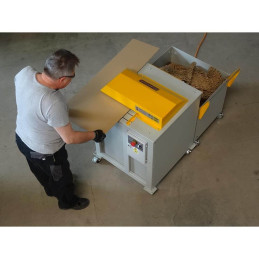
Reference: PVE100150FRAGILE
Adhesive label 100x150mm - FRAGILE Handle with care 1pc.
- The sticker is intended for marking packages
- Warning about the fragile contents of the package
- International icon FRAGILE
- The price is for 1 pc.
Reference: PVE100150FRAGILE
Reference: F0201_150/150/100B11R
Reference: F0201_150/150/69B11R
Reference: IND3717REDNB
Reference: PVE100150STIKLAS




Ekomet STANDARD 1 is an innovative, sustainability-promoting cardboard recycling device. With the help of this device, you will be able to recycle the available cardboard waste without much effort and turn it into an effective packaging volume filler. High-quality equipment components ensure the durability and long service life of the device. In an hour, on average, with the help of this device, you will be able to produce/process about 6.6m³ of cardboard raw material in your company's premises, which you can use as a sustainable, efficient, light, and most importantly 100% recyclable, packaging material. Using this type of volume filler only improves the image of the company.
Delivery time for this device is 4-6 weeks
Cardboard perforating machines are specialized devices designed to create evenly spaced cuts or grooves in cardboard and other similar materials. These cuts allow the cardboard to be easily bent, folded, or manipulated, making it flexible and suitable for various packaging applications. These machines are widely used in the packaging industry to create custom packaging solutions, especially for items that require secure and protective packaging. Also businesses can experience several benefits by using cardboard perforating machines and recycling cardboard leftovers generated from their regular business activities. Here are some of the key benefits:
It's important for businesses to conduct a cost-benefit analysis and consider factors such as initial investment in perforating machinery, operational costs, and potential savings over time. Additionally, proper training and maintenance of the perforating machines are crucial to ensure optimal performance and safety.
By implementing cardboard recycling and perforation practices, businesses can not only contribute to environmental conservation but also unlock various operational, financial, and branding advantages.